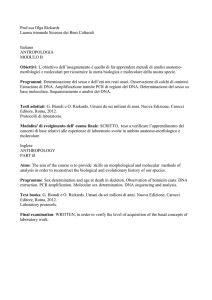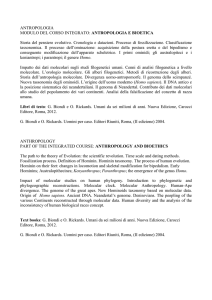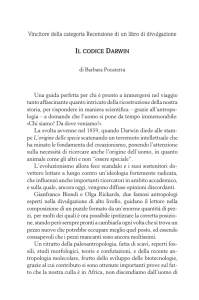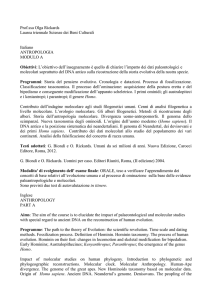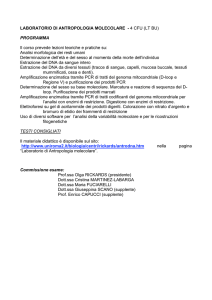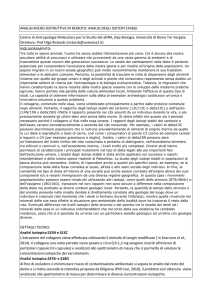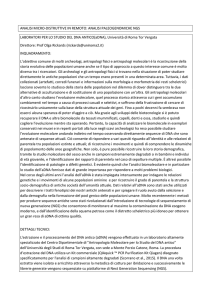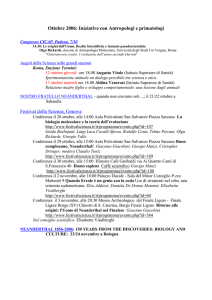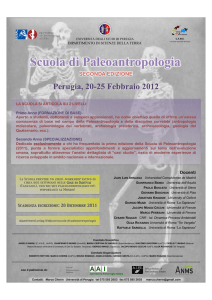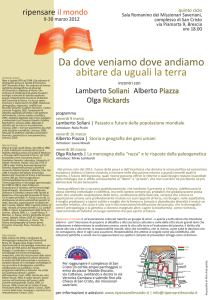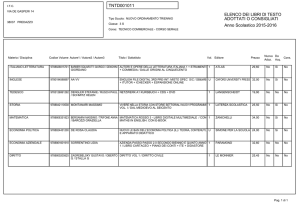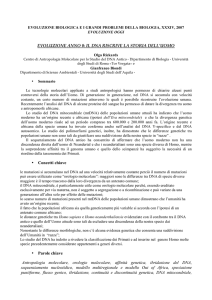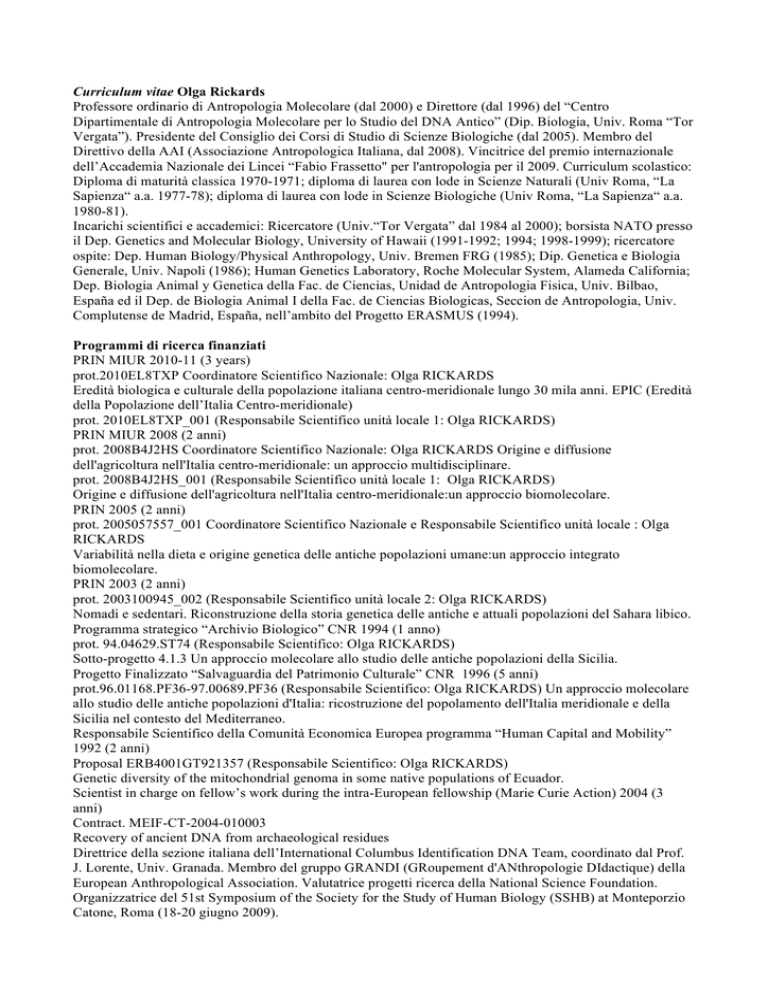
Curriculum vitae Olga Rickards
Professore ordinario di Antropologia Molecolare (dal 2000) e Direttore (dal 1996) del “Centro
Dipartimentale di Antropologia Molecolare per lo Studio del DNA Antico” (Dip. Biologia, Univ. Roma “Tor
Vergata”). Presidente del Consiglio dei Corsi di Studio di Scienze Biologiche (dal 2005). Membro del
Direttivo della AAI (Associazione Antropologica Italiana, dal 2008). Vincitrice del premio internazionale
dell’Accademia Nazionale dei Lincei “Fabio Frassetto" per l'antropologia per il 2009. Curriculum scolastico:
Diploma di maturità classica 1970-1971; diploma di laurea con lode in Scienze Naturali (Univ Roma, “La
Sapienza“ a.a. 1977-78); diploma di laurea con lode in Scienze Biologiche (Univ Roma, “La Sapienza“ a.a.
1980-81).
Incarichi scientifici e accademici: Ricercatore (Univ.“Tor Vergata” dal 1984 al 2000); borsista NATO presso
il Dep. Genetics and Molecular Biology, University of Hawaii (1991-1992; 1994; 1998-1999); ricercatore
ospite: Dep. Human Biology/Physical Anthropology, Univ. Bremen FRG (1985); Dip. Genetica e Biologia
Generale, Univ. Napoli (1986); Human Genetics Laboratory, Roche Molecular System, Alameda California;
Dep. Biologia Animal y Genetica della Fac. de Ciencias, Unidad de Antropologia Fisica, Univ. Bilbao,
España ed il Dep. de Biologia Animal I della Fac. de Ciencias Biologicas, Seccion de Antropologia, Univ.
Complutense de Madrid, España, nell’ambito del Progetto ERASMUS (1994).
Programmi di ricerca finanziati
PRIN MIUR 2010-11 (3 years)
prot.2010EL8TXP Coordinatore Scientifico Nazionale: Olga RICKARDS
Eredità biologica e culturale della popolazione italiana centro-meridionale lungo 30 mila anni. EPIC (Eredità
della Popolazione dell’Italia Centro-meridionale)
prot. 2010EL8TXP_001 (Responsabile Scientifico unità locale 1: Olga RICKARDS)
PRIN MIUR 2008 (2 anni)
prot. 2008B4J2HS Coordinatore Scientifico Nazionale: Olga RICKARDS Origine e diffusione
dell'agricoltura nell'Italia centro-meridionale: un approccio multidisciplinare.
prot. 2008B4J2HS_001 (Responsabile Scientifico unità locale 1: Olga RICKARDS)
Origine e diffusione dell'agricoltura nell'Italia centro-meridionale:un approccio biomolecolare.
PRIN 2005 (2 anni)
prot. 2005057557_001 Coordinatore Scientifico Nazionale e Responsabile Scientifico unità locale : Olga
RICKARDS
Variabilità nella dieta e origine genetica delle antiche popolazioni umane:un approccio integrato
biomolecolare.
PRIN 2003 (2 anni)
prot. 2003100945_002 (Responsabile Scientifico unità locale 2: Olga RICKARDS)
Nomadi e sedentari. Riconstruzione della storia genetica delle antiche e attuali popolazioni del Sahara libico.
Programma strategico “Archivio Biologico” CNR 1994 (1 anno)
prot. 94.04629.ST74 (Responsabile Scientifico: Olga RICKARDS)
Sotto-progetto 4.1.3 Un approccio molecolare allo studio delle antiche popolazioni della Sicilia.
Progetto Finalizzato “Salvaguardia del Patrimonio Culturale” CNR 1996 (5 anni)
prot.96.01168.PF36-97.00689.PF36 (Responsabile Scientifico: Olga RICKARDS) Un approccio molecolare
allo studio delle antiche popolazioni d'Italia: ricostruzione del popolamento dell'Italia meridionale e della
Sicilia nel contesto del Mediterraneo.
Responsabile Scientifico della Comunità Economica Europea programma “Human Capital and Mobility”
1992 (2 anni)
Proposal ERB4001GT921357 (Responsabile Scientifico: Olga RICKARDS)
Genetic diversity of the mitochondrial genoma in some native populations of Ecuador.
Scientist in charge on fellow’s work during the intra-European fellowship (Marie Curie Action) 2004 (3
anni)
Contract. MEIF-CT-2004-010003
Recovery of ancient DNA from archaeological residues
Direttrice della sezione italiana dell’International Columbus Identification DNA Team, coordinato dal Prof.
J. Lorente, Univ. Granada. Membro del gruppo GRANDI (GRoupement d'ANthropologie DIdactique) della
European Anthropological Association. Valutatrice progetti ricerca della National Science Foundation.
Organizzatrice del 51st Symposium of the Society for the Study of Human Biology (SSHB) at Monteporzio
Catone, Roma (18-20 giugno 2009).
Impegni didattici: Antropologia Molecolare, Antropologia, Biologia delle Popolazioni Umane (lauree V.O.,
lauree triennali, lauree specialistiche dell’Università “Tor Vergata”: Fac. Sc. M.F.N., Fac. Lettere e
Filosofia); Antropologia (lauree V.O. dell’Università della “Tuscia”, Viterbo, 1994-2000: Fac. Sc. M.F.N.,
Fac. Conservazione Beni Culturali); Antropologia (lauree specialistiche dell’Univ. Cassino: Fac. Lettere e
Filosofia –a.a. 2004-2005); Antropologia Molecolare (European Master in Anthropology e Human Biology
programme, Univ. Firenze). Docente al Master universitario di II livello in modalità teledidattica Natura e
Scienze, Episteme e Didattica (NAT) modulo: Genetica e antropologia oggi: evoluzione, salute, OGM e al
Master in Comunicazione della Scienza dell’Univ. “Tor Vergata”, e al Master in Giornalismo Scientifico
della SISSA di Trieste. Membro del Consiglio del Master di primo livello in Comunicazione della Scienza e
Membro del Dottorato in Biologia Evoluzionistica ed Ecologia (Univ. “Tor Vergata”).
Membro del Senato Accademico Integrato Univ. “Tor Vergata” (dal 1993 al 1998).
Autrice di numerose pubblicazioni scientifiche su riviste internazionali e nazionali e di capitoli di libri.
Attività di divulgazione scientifica: autrice di diversi libri sull’evoluzione umana, di numerosi articoli su
quotidiani e riviste generaliste e specializzate, di voci per enciclopedie nazionali ed internazionali.
Curatore di numerose mostre nazionali sul tema dell'evoluzione umana("Senza Adamo Senza Eva" – 1998
Roma, 2001 Martina Franca,Taranto; "Dimenticando Adamo" – 2002 Piancastagnaio, Siena, 2003 Viterbo,
2005 Sant’Angelo Muxaro, Agrigento; “Lucy in the sky with diamonds: alle origini dell’uomo” – 2007
Modena; Evoluzioni. Le scienze tra natura e numeri – 2007 Monte Porzio Catone, Roma).
Scientific organizer and director of the international workshop “Ancient DNA analysis: a new servant to
Archaeoanthropology and Forensic Medicine” Bioroma 2000, Università degli Studi di Roma “Tor Vergata”,
30-31 marzo 2000.
Ha partecipato a numerosi programmi televisivi e radiofonici (Rai Educational, Rai 3, Canale 5 e National
Geographic; e di Radio 1, Radio 2 e Radio 3). Da giugno 2007 è autrice del blog: “darwinpunk: selezione
(in)naturale di pensieri sull’evoluzione dell’uomo e dintorni” su Nova100 de ilsole24 ore
(http://rickardsbiondi.nova100.ilsole24ore.com/).
E’ intervenuta come invitato a Seminari internazionali e nazionali.Nel 2009 è stata invitata a presentare una
main lecture alla Peer-reviewed and internationally established conference Biological evolution: facts and
theories. A critical appraisal 150 years after "The origin of species" Roma, 3-7 March 2009, Gregorian
University, Rome, che è stata pubblicata sui Proceedings of the Conference: RICKARDS O, BIONDI G
(2011). The origin of man: molecular approach. In: Biological evolution: facts and theories. A critical
appraisal 150 years after "The origin of species" (G. Auletta, M. Leclerc, R.A. Martinez, eds.). Roma, 3-7
March 2009, p. 225-241, ROME: Gregorian and Biblical Press, ISBN: 978-88-7839-180-2).
Membro di numerose società scientifiche internazionali e nazionali. Editor dal 2004 della rivista scientifica
internazionale Annals of Human Biology (Informa). Membro dell’Editorial Board della Revista Española de
Antropologia Biologica e del Comitato Scientifico della Rivista Antropo. Revisore per riviste scientifiche
internazionali e nazionali.
Spedizioni e campagne di ricerca:
Sahara libico-campagna di campionamento della popolazione attuale Tuareg (Al Awaynat e Tahala; gennaiofebbraio 2004).
Olduvai Gorge, Great Rift Valley nella Tanzania settentrionale-coordinatore scientifico e supervisore del
field-workshop organizzato dall'Università di Perugia nell'ambito della prima edizione della Scuola di
Paleoantropologia tenutasi a Perugia dal 14 al 18 febbraio 2011 (1-15 settembre 2011).
Campi di interesse: Evoluzione Umana, polimorfismi del DNA mitocondriale e nucleare, aDNA,
archeoantropologia molecolare, analisi degli isotopi stabili, paleodieta e migrazione delle popolazioni
umane.
E' attualmente responsabile dei seguenti programmi scientifici:
1-Approccio molecolare allo studio delle popolazioni antiche d'Italia: ricostruzione del popolamento
dell'Italia nel contesto del bacino del Mediterraneo. La ricerca è finalizzata alla ricostruzione della storia
genetica d'Italia utilizzando i dati molecolari. Confrontando diacronicamente segmenti del genoma
antropologicamente ricchi di informazioni (anche applicando il NGS) ottenuti da popolazioni antiche e
attuali (provenienti da diverse regioni d'Italia, dal Mediterraneo, dal nord Africa e dal Medio Oriente), è
possibile valutare quale sia stato l'effettivo contributo di ciascun popolo al patrimonio genetico italiano;
nonché risolvere i casi dubbi di determinazione di sesso (analizzando il DNA dei cromosomi sessuali) e
accertare rapporti di parentela nelle sepolture multiple. In particolare, sono stati analizzati reperti provenienti
da siti che coprono un arco temporale che va dal Paleolitico al Medioevo (Balzi Rossi, Arene Candide,
Ostuni, Romito, Grotta delle Veneri, Samari, Fontenoce di Recanati, Sant'Angelo Muxaro, Ticchiara,
Madonna di Loreto, Monte Vodice, Ipogeo degli Aureli, Ferento). In collaborazione con diversi colleghi
italiani e stranieri (Univ. e Sopr. Beni Archeologici).
2-Ricostruzione molecolare delle linee materne in popolazioni moderne del Sahara libico: scopo di questa
ricerca è quello di caratterizzare a livello del DNA mitocondriale popolazioni moderne del Sahara libico, al
fine di contribuire al chiarimento delle modalità e dinamiche di diffusione umana nell'area. Per ricostruire gli
antichi movimenti popolazionistici nel Sahara libico abbiamo effettuato l'analisi molecolare di un campione
di 131 individui della popolazione attuale Tuareg nelle città di Al Awaynat e Tahala. In collaborazione con
colleghi italiani e spagnoli.
3-Ricostruzione delle migrazioni umane su base molecolare: il contributo di questo programma
all'individuazione delle antiche rotte di migrazione di sapiens è consistito nello studio della variabilità del
mtDNA in popolazioni dell'Africa occidentale e orientale e dell'Europa, con particolare riguardo all'area
mediterranea, e in gruppi mescolati ed autoctoni del Sud America. Queste popolazioni sono state anche
analizzate per altri marcatori nucleari (APOE; COL1A2; CYP1A1; PON1; Immunoglobulin Enhancer
HS1,2) tra i quali rivestono particolare interesse quelli del cromosoma Y, la controparte maschile del
mtDNA. In collaborazione con diversi colleghi italiani e stranieri.
4-Caratterizzazione molecolare della popolazione antica romana di Velia e delle popolazioni del Neolitico
antico dell'Italia centro-meridionale: sono stati saggiati metodi per estrarre insieme e in modo riproducibile
DNA e collagene da ossa antiche; è stato valutato, dalla quantità di collagene residuo, il grado di
conservazione dei reperti da sottoporre all’analisi dell’aDNA; è stata ricostruita la dieta della popolazione,
analizzando il rapporto degli isotopi stabili del C e del N presenti nel collagene dei resti umani e animali,
consumati; stimata la variazione nella dieta rispetto ad età, sesso e tipo di sepoltura. In collaborazione con
diversi colleghi italiani e stranieri.
Curriculum vitae Olga Rickards
Born in Rome, July 20th 1952.
ACADEMIC TITLES
- She achieved her Ph.D. in Natural Sciences at Sapienza – Università di Roma (1978 in Anthropology).
- She achieved her Ph.D. in Biological Sciences at Sapienza – Università di Roma (1981 in Molecular
Anthropology).
- She became in 1984 Assistant Professor of Molecular Anthropology at Tor Vergata – Università di Roma.
- She became in 2000 Full (Ordinarius) Professor of Molecular Anthropology at Tor Vergata – Università di
Roma.
At Tor Vergata University she has served as:
- Head of the “Departmental Centre of Molecular Anthropology for ancient DNA studies” (since 1996;
Department of Biology).
- President of the First and Second level Degree Courses in Biology (since 2005).
- Member of the PhD Committee in Evolutionary Biology and Ecology (since 1993).
- Member of the Senato Accademico Integrato (1993-1998).
Long/short term research appointments
- NATO fellow, Department of Genetics and Molecular Biology, University of Hawaii (1998-1999;
1991-1992; 1994);
- Research Specialist: Department of Human Biology/Physical Anthropology, University of Bremen FRG
(1985); Department of Genetics, General Biology, University of Naples (1986); Department of Animal
Biology, University of Barcelona (1990); Human Genetics Laboratories, Roche Molecular System, Alameda
California (1993), Department of Animal Biology, University of Bilbao (1995);Department of Animal
Biology, Complutense University of Madrid (1996, 1997 ERASMUS project).
Editor of the International Journal “Annals of Human Biology” (Publisher: Informa Healthcare, London)
(since 2004).
Officer of the Italian Anthropological Association (since 2007).
Olga Rickards was one of the first scientist in Italy to apply Molecular Anthropology to the reconstruction of
the origin and history of human populations, traditionally studied through palaeontology and archaeology.
Since the early seventies, her research group has investigated human genetic variability first at protein and
afterwards at DNA level. This data was used to explore the evolutionary history of human populations living
in various geographical areas, providing a quantitative and temporal framework that was unavailable from
other types of evidence. Since 1990’s her research has focused on the characterization of ancient genetic
material from prehistoric peoples of Italy, North Africa and South America and the comparison with
sequence data from modern populations.
Scientific director of the Italian group of the International Columbus Identification DNA Team
(coordinator Prof. J. Lorente, University of Granada).
Member of GRANDI (GRoupement d'ANthropologie DIdactique) EAA.
Reviewer of the National Science Foundation grants.
Invited speaker in international and national meetings.
Member of several international and national scientific associations.
Member of the Editorial Board of the Revista Española de Antropologia Biologica.
Member of the Scientific Committee of the on-line journal Antropo.
Reviewer for international and national scientific journals.
Curator of national exhibitions on human evolution ("Senza Adamo Senza Eva" – 1998 Roma, 2001
Martina Franca,Taranto; "Dimenticando Adamo" – 2002 Piancastagnaio, Siena, 2003 Viterbo, 2005
Sant’Angelo Muxaro, Agrigento; “Lucy in the sky with diamonds: alle origini dell’uomo” – 2007
Modena; Evoluzioni. Le scienze tra natura e numeri – 2007 Monte Porzio Catone, Roma).
Scientific organizer and director of the international workshop “Ancient DNA analysis: a new
servant to Archaeoanthropology and Forensic Medicine” Bioroma 2000, Università degli Studi di
Roma “Tor Vergata”, 30-31 marzo 2000.
She is author of a blog, reporting news on human evolution, of nova100 ilsole24ore
(http://rickardsbiondi.nova100.ilsole24ore.com/).
Research Interests: Human evolution, mtDNA and nuclear polymorphisms, ancient DNA, stable
isotope analysis for reconstructing genetic history, palaeodiet and migrations of ancient populations.
RESEARCH GRANT
PRIN MIUR (Italian Ministry for the Universities) 2010-11 (3 years)
prot.2010EL8TXP National Scientific Coordinator: Olga RICKARDS (838.429 euro)
Biological and cultural heritage of the central-southern Italian population trough 30 thousand
Years EPIC (Eredità della Popolazione dell’Italia Centro-meridionale)
prot. 2010EL8TXP_001 (Principal investigator local unit 1: Olga RICKARDS) (264.585 euro)
PRIN MIUR (Italian Ministry for the Universities) 2008 (2 years)
prot. 2008B4J2HS National Scientific Coordinator: Olga RICKARDS (156,098 euro)
Origin and diffusion of farming in central-southern Italy: a multidisciplinary approach.
prot. 2008B4J2HS_001 (Principal investigator local unit 1: Olga RICKARDS) (126,429 euro)
Origin and diffusion of farming in central-southern Italy: a molecular approach.
PRIN (Italian Ministry for the Universities) 2005 (2 years)
prot. 2005057557_001 National Scientific Coordinator and Principal investigator local unit: Olga
RICKARDS (128,600 euro)
Dietary variability and genetic origins of ancient human populations: a combined ancient biomolecular
approach.
PRIN (Italian Ministry for the Universities) 2003 (2 years)
Nomads and sedentary people. Climatic variations, population dynamics and cultural tracks in Africa and
Asia during Olocene.
National Scientific Coordinator: Mario LIVERANI
prot. 2003100945_002 (Principal investigator local unit 2: Olga RICKARDS) (88,200 euro)
Nomads and sedentary people. Reconstruction of the genetic history of ancient and extant populations from
Libyan Sahara.
Strategic programme “Biological Archive” CNR (National Research Council) 1994 (1 year)
prot. 94.04629.ST74 (Scientific leader: Olga RICKARDS) (50,000 Euro)
Sub-project 4.1.3 A molecular approach to the study of ancient populations of Sicily.
Special Project “Safeguard of the Cultural Heritage” CNR (National Research Council) 1996 (5 years)
prot.96.01168.PF36-97.00689.PF36 (Scientific leader: Olga RICKARDS) (500,000 euro)
Molecular approach to the study of the ancient Italian populations: reconstruction of the peopling of
southern Italy and Sicily in the frame of the Mediterranean Basin.
Scientific Leader of the European Economic Community programme “Human Capital and Mobility” 1992
(2 years)
Proposal ERB4001GT921357 (Scientific leader: Olga RICKARDS) (98,951 euro)
Genetic diversity of the mitochondrial genoma in some native populations of Ecuador.
Scientist in charge on fellow’s work during the intra-European fellowship (Marie Curie Action) 2004 (3
years)
Contract. MEIF-CT-2004-010003 (17,661.62)
Recovery of ancient DNA from archaeological residues
10-year track-record
The research activity of Olga Rickards is characterized by a methodology and perspective involving both a
strong engagement as a field anthropologist, with a personal and direct participation in sample collections,
and a remarkable interdisciplinary approach, dealing with archaeology, geology, ecology, physical and
molecular anthropology, botany, zoology and biochemistry, to the reconstruction of human populations
history and evolution as evinced in her publications (more than 150).
The main research expeditions Olga Rickards participated to were carried out:
1. at Tahala and El-Awinat villages (Libyan Sahara) in 2004, as part of the Italian-Libyan
Archaeological Mission in the Acacus and Messak of the Sapienza University of Rome and the
Department of Antiquities, Tripoli, directed by Prof. Savino di Lernia and the late Ebrahim Azzebi,
and aimed to clarify the genetic composition and origin of the extant Libyan Tuaregs and their
possible relationships with the Garamantes people;
2. and at Olduvai Gorge, near the Great Rift Valley in northern Tanzania in 2011, as cohordinator and
supervisor of the field-workshop organized by the University of Perugia in the frame of the first
edition of the Palaeoantropology school held in Perugia on 14-18 February 2011.
Olga Rickards was the scientific organizer of the 51st International Symposium of the Society for the Study
of Human Biology, held at Monteporzio Catone, Roma, in 2009 on the theme of 'Human Dispersals'. The
aim of the Symposium was to reconstruct human colonization and migrations out of Africa applying
traditional and new approaches such as archaeology, genetics, molecular anthropology, the recovery and
analyses of ancient biomolecules, food production and human diet.
In 2009 she was awarded the Accademia Nazionale dei Lincei International Prize “Fabio Frassetto" for
anthropology for her scientific research in the field of molecular anthropology with special mention to
ancient DNA studies.
She was invited to present a main lecture to the peer-reviewed and internationally established conference
Biological evolution: facts and theories. A critical appraisal 150 years after "The origin of species" Roma,
3-7 March 2009, Gregorian University, Rome, which was published in the Proceedings of the Conference:
RICKARDS O, BIONDI G (2011). The origin of man: molecular approach. In: Biological evolution: facts
and theories. A critical appraisal 150 years after "The origin of species" (G. Auletta, M. Leclerc, R.A.
Martinez, eds.). Roma, 3-7 March 2009, p. 225-241, ROME: Gregorian and Biblical Press, ISBN: 978-887839-180-2).
Curator of national exhibitions on human evolution, and of international workshops and meetings on ancient
DNA.
Articoli selezionati/Selected Articles
RICKARDS O, BIONDI G, DE STEFANO GF, VECCHI F, WALTER H (1992). GENETIC-STRUCTURE
OF THE POPULATION OF SICILY. AMERICAN JOURNAL OF PHYSICAL ANTHROPOLOGY, vol.
87, p. 395-406.
TITUS EAB, KLITZ W, RICKARDS O, DESTEFANO GF, ERLICH HA (1993). HLA CLASS-II
EVOLUTION IN THE CAYAPA INDIANS OF ECUADOR. HUMAN IMMUNOLOGY, vol. 37, p. 16.
LUM JK, RICKARDS O, CHING C, CANN RL (1994). POLYNESIAN MITOCHONDRIAL DNAS
REVEAL 3 DEEP MATERNAL LINEAGE CLUSTERS. HUMAN BIOLOGY, vol. 66, p. 567-590.
TITUS TRACHTENBERG EA, RICKARDS O, DESTEFANO GF, ERLICH HA (1994). ANALYSIS OF
HLA CLASS-II HAPLOTYPES IN THE CAYAPA INDIANS OF ECUADOR - A NOVEL DRB-I
ALLELE REVEALS EVIDENCE FOR CONVERGENT EVOLUTION AND BALANCING SELECTION
AT POSITION-86. AMERICAN JOURNAL OF HUMAN GENETICS, vol. 55, p. 160-167.
TRACHTENBERG EA, ERLICH HA, RICKARDS O, DESTEFANO GF, KLITZ W (1995). HLA CLASSII LINKAGE DISEQUILIBRIUM AND HAPLOTYPE EVOLUTION IN THE CAYAPA INDIANS OF
ECUADOR. AMERICAN JOURNAL OF HUMAN GENETICS, vol. 57, p. 415-424.
TARTAGLIA M, SCACCHI R, CORBO RM, POMPEI F, RICKARDS O, CIMINELLI BM,
SANGATRAMANI T, VYAS M, DASH S, MODIANO G (1995). Genetic heterogeneity among the Hindus
and their relationships with the other 'Caucasoid' populations: new data on Punjab-Haryana and Rajasthan
Indian States. AMERICAN JOURNAL OF PHYSICAL ANTHROPOLOGY, vol. 98, p. 257-273.
RICKARDS O (1995). Analysis of the region V mitochondrial marker in two African-American
communities of Ecuador and in their parental populations. HUMAN EVOLUTION, vol. 10, p. 5-16.
BIONDI G, RICKARDS O, MARTINEZ LABARGA C, TARABORELLI T, CIMINELLI B, GRUPPIONI
G (1996). Biodemography and genetics of the Berba of Benin. AMERICAN JOURNAL OF PHYSICAL
ANTHROPOLOGY, vol. 99, p. 519-535.
PEPE G, VANEGAS OC, GIUSTI B, BRUNELLI T, MARCUCCI R, ATTANASIO M, RICKARDS O, DE
STEFANO GF, PRISCO D, GENSINI GF, ABBATE R (1998). Heterogeneity in world distribution of the
thermolabile C677T mutation in 5,10-methylenetetrahydrofolate reductase. AMERICAN JOURNAL OF
HUMAN GENETICS, vol. 63, p. 917-920.
RICKARDS O, MARTINEZ-LABARGA C, LUM JK, DE STEFANO GF, CANN RL (1999). mtDNA
history of the Cayapa Amerinds of Ecuador: Detection of additional founding lineages for the native
American populations. AMERICAN JOURNAL OF HUMAN GENETICS, vol. 65, p. 519-530.
PEPE G, VANEGAS OC, RICKARDS O, GIUSTI B, COMEGLIO P, BRUNELLI T, MARCUCCI R,
PRISCO D, GENSINI GF, ABBATE R (1999). World distribution of the TS33C/844INS68 CBS in cis
double mutation: a reliable anthropological marker. HUMAN GENETICS, vol. 104, p. 126-129.
MARTINEZ-LABARGA C, RICKARDS O, SCACCHI R, CORBO RM, BIONDI G, PENA JA, DE
VIEIRA CV, GUEVARA AEB, SANTURINO MSM, DE STEFANO GF (1999). Genetic population
structure of two African-Ecuadorian communities of Esmeraldas. AMERICAN JOURNAL OF PHYSICAL
ANTHROPOLOGY, vol. 109, p. 159-174.
SCOZZARI R, CRUCIANI F, SANTOLAMAZZA P, MALASPINA P, TORRONI A, SELLITTO D,
ARREDI B, DESTRO-BISOL G, DE STEFANO G, RICKARDS O, MARTINEZ-LABARGA C,
MODIANO D, BIONDI G, MORAL P, OLCKERS A, WALLACE DC, NOVELLETTO A (1999).
Combined use of biallelic and microsatellite Y-chromosome polymorphisms to infer affinities among
African populations. AMERICAN JOURNAL OF HUMAN GENETICS, vol. 65, p. 829-846.
TARAZONA-SANTOS E, CARVALHO-SILVA DR, PETTENER D, LUISELLI D, DE STEFANO GF,
LABARGA CM, RICKARDS O, TYLER-SMITH C, PENA SDJ, SANTOS FR (2001). Genetic
differentiation in South Amerindians is related to environmental and cultural diversity: Evidence from the Y
chromosome. AMERICAN JOURNAL OF HUMAN GENETICS, vol. 68, p. 1485-1496.
RICKARDS O, MARTINEZ-LABARGA C, FAVARO M, FREZZA D, MALLEGNI F (2001). DNA
analyses of the remains of the Prince Branciforte Barresi family. INTERNATIONAL JOURNAL OF
LEGAL MEDICINE, vol. 114, p. 141-146.
TORRONI A, BANDELT HJ, MACAULAY V, RICHARDS M, CRUCIANI F, RENGO C, MARTINEZCABRERA V, VILLEMS R, KIVISILD T, METSPALU E, PARIK JR, TOLK HV, TAMBETS K,
FORSTER P, KARGER B, FRANCALACCI P, RUDAN P, JANICIJEVIC B, RICKARDS O,
SAVONTAUS ML, HUOPONEN K, LAITINEN V, KOIVUMAKI S, SYKES B, HICKEY E,
NOVELLETTO A, MORAL P, SELLITTO D, COPPA A, AL-ZAHERI N, SANTACHIARA-
BENERECETTI AS, SEMINO O, SCOZZARI R (2001). A signal, from human mtDNA, of postglacial
recolonization in Europe. AMERICAN JOURNAL OF HUMAN GENETICS, vol. 69, p. 844-852.
REIDLA M., KIVISILD T., METSPALU E., KALDMA K., TAMBETS K., TOLK H.V., PARIK J.,
LOOGVÄLI E.L., DERENKO M., MALYARCHUK B., BERMISHEVA M., ZHADANOV S.,
PENNARUN E., GUBINA M., GOLUBENKO M., DAMBA L., FEDOROVA S., GUSAR V.,
GRECHANINA E., MIKEREZI I., MOISAN J.P., CHAVENTRÉ A., KHUSNUTDINOVA E., OSIPOVA
L., STEPANOV V., VOEVODA M., ACHILLI A., RENGO C., RICKARDS O., DE STEFANO G.F.,
PAPIHA S., BECKMAN L., JANICIJEVIC B., RUDAN P., ANAGNOU N., MICHALODIMITRAKIS E.,
KOZIEL S., USANGA E., GEBERHIWOT T., HERRNSTADT C., HOWELL N., TORRONI A.,
VILLEMS R. (2003) Origin and diffusion of mtDNA haplogroup X. AMERICAN JOURNAL HUMAN
GENETICS, vol. 73, pp. 1178-90.
BABALINI C., MARTINEZ-LABARGA C., TOLK H.V., KIVISILD T., GIAMPAOLO R., TARSI
T., CONTINI I., BARAC L., JANICIJEVIC B., MARTINOVIC KLARIC I., PERICIC M., SUJOLDZIC A.,
VILLEMS R., BIONDI G., RUDAN P., RICKARDS O. (2005). The genetic history of the Croatian
linguistic minority of Molise (southern Italy): a maternal view. EUROPEAN JOURNAL OF HUMAN
GENETICS, vol. 13, pp. 902-912.
LUCIANI S., FORNACIARI G., RICKARDS O., MARTINEZ-LABARGA C., ROLLO F. (2006)
Molecular characterization of a pre-Columbian mummy and in situ coprolite. AMERICAN JOURNAL
PHYSICAL ANTHROPOLOGY, vol. 129, pp.620-9.
KEMP B.M., MALHI R.S., MCDONOUGH J., BOLNICK D.A., ESHLEMAN J.A., RICKARDS O.,
MARTINEZ-LABARGA C., JOHNSON J.R., LORENZ J.G., DIXON E.J., FIFIELD T.E., HEATON T.H.,
WORL R., SMITH D.G. (2007) Genetic analysis of early holocene skeletal remains from Alaska and its
implications for the settlement of the Americas. AMERICAN JOURNAL PHYSICAL ANTHROPOLOGY,
vol. 132, pp.605-21.
TAMM E., KIVISILD T., REIDLA M., METSPALU M., SMITH D.G., MULLIGAN C.J., BRAVI
C.M., RICKARDS O., MARTINEZ-LABARGA C., KHUSNUTDINOVA E.K., FEDOROVA S.A.,
GOLUBENKO M.V., STEPANOV V.A., GUBINA M.A., ZHADANOV S.I., OSSIPOVA L.P., DAMBA
L., VOEVODA M.I., DIPIERRI J.E., VILLEMS R., MALHI R.S. (2007) Beringian standstill and spread of
Native American founders. PLOS One.2(9):e829.
OTTONI C., MARTÍNEZ-LABARGA C., LOOGVÄLI E.L., PENNARUN E., ACHILLI A., DE
ANGELIS F., TRUCCHI E., CONTINI I., BIONDI G., RICKARDS O. (2009) First genetic insight into
Libyan Tuaregs: a maternal perspective. ANNALS OF HUMAN GENETICS, vol. 73: 438-48).
CRAIG O.E., BIAZZO M., O'CONNELL T.C., GARNSEY P., MARTINEZ-LABARGA C., LELLI
R., SALVADEI L., TARTAGLIA G., NAVA A., RENÒ L., FIAMMENGHI A., RICKARDS O.,
BONDIOLI L. (2009). Stable isotopic evidence for diet at the Imperial Roman coastal site of Velia (1st and
2nd centuries AD) in Southern Italy. AMERICAN JOURNAL PHYSICAL ANTHROPOLOGY, vol. 139,
pp.572-83.
CRAIG, O.E., BIAZZO, M., COLONESE, A.C., DI GIUSEPPE, Z., MARTINEZ-LABARGA, C.,
LO VETRO, D., LELLI, R., MARTINI, F., RICKARDS, O. (2010) Stable isotope analysis of Late Upper
Palaeolithic human and faunal remains from Grotta del Romito (Cosenza), Italy. JOURNAL OF
ARCHAEOLOGICAL SCIENCE, vol. 37, p. 2504-2512 .
OTTONI, C., PRIMATIVO, G., HOOSHIAR KASHANI, B., ACHILLI, A.,
MARTÍNEZ-LABARGA, C., BIONDI, G., TORRONI, A., RICKARDS O. (2010) Mitochondrial
Haplogroup H1 in North Africa: An Early Holocene Arrival from Iberia. PLOS ONE 5(10): e13378.
doi:10.1371/journal.pone.0013378.
OTTONI, C., LARMUSEAU, M.H.D., VANDERHEYDEN, M., MARTINEZ-LABARGA, C.,
PRIMATIVO, G., BIONDI, G., DECORTE, R., RICKARDS, O. (2011) Deep Into the Roots of the Libyan
Tuareg: A Genetic Survey of Their Paternal Heritage. AMERICAN JOURNAL OF PHYSICAL
ANTHROPOLOGY, vol. 145(1), p. 118-24.
GASBARRINI G, RICKARDS O, MARTÍNEZ-LABARGA C, PACCIANI E, CHILLERI F, LATERZA L,
MARANGI G, SCALDAFERRI F, GASBARRINI A (2012). The origin of celiac disease: How old are
predisposing haplotypes? . WORLD JOURNAL OF GASTROENTEROLOGY, vol. 18, p. 5300-53004.
MARTÍNEZ-GONZÁLEZ LJ, MARTÍNEZ-ESPÍN E, ALVAREZ JC, ALBARDANER F, RICKARDS O,
MARTÍNEZ-LABARGA C, CALAFELL F, LORENTE JA (2012). Surname and Y chromosome in
Southern Europe: a case study with Colom/Colombo. EUROPEAN JOURNAL OF HUMAN GENETICS,
vol. 20, p. 2011-2016.
GISMONDI A, ROLFO MF, LEONARDI D, RICKARDS O, CANINI A (2012). Identification of ancient
Olea europaea L. and Cornus mas L. seeds by DNA barcode. COMPTES RENDUS BIOLOGIES, vol. 335 ,
p. 472-479.
LELLI R, ALLEN R, BIONDI G, CALATTINI M, CONATI BARBARO C, GORGOGLIONE MA,
MANFREDINI A, MARTÍNEZ-LABARGA C, RADINA F, SILVESTRINI M, TOZZI C, RICKARDS O,
CRAIG OE (2012). Examining dietary variability of the earliest farmers of south-eastern Italy. AMERICAN
JOURNAL OF PHYSICAL ANTHROPOLOGY, vol. 149, p. 380-390.
J A HOLLENBACH, D G AUGUSTO, C ALAEZ, L BUBNOVA, I FAE, G. FISCHER, F F GONZALEZGALARZA, C GORODEZKY, L KARABON, P KUSNIERCZYK, J NOBLE, RICKARDS O, C
ROBERTS, M SCHAFFER, L SHI, S TAVOULARIS, E TRACHTENBERG, Y YAO & D MIDDLETON
(2013). 16th IHIW: Population Global Distribution of Killer Immunoglobulin-like Receptor (KIR) and
Ligands. INTERNATIONAL JOURNAL OF IMMUNOGENETICS, vol. 40, p. 39-45.
Ciaffi R, Lelli R, Muldner G, Stantcheva K, Fischetti AL, Ghini G, Craig OE, Milano F, Rickards O, Arcudi
G, Martinez-Labarga C (in press). Palaeobiology of the Medieval population of Albano (Rome, Italy): a
combined morphological and biomolecular approach. INTERNATIONAL JOURNAL OF
OSTEOARCHAEOLOGY.
-Monografie/Monographs
G. BIONDI, O. RICKARDS (2011). L’errore della razza. Avventure e sventure di un mito pericoloso.
ROMA:Carocci Editore, ISBN: 978-88-430-6092-4.
G. BIONDI, O. RICKARDS (2009). Umani da sei milioni di anni. ROMA:Carocci Editore, ISBN:
978-88-430-5113-7.
G. BIONDI, F. GHIONE, O. RICKARDS, V. SBORDONI (2008). Evoluzioni. Le Scienze tra Natura e
Numeri. Antropologia, Biodiversità, Matematica. Roma: OMgrafica, ISBN: 978-88-95688-02-2.
G. BIONDI, F. MARTINI, O. RICKARDS, G. ROTILIO (2006). In carne e ossa. DNA, cibo e culture
dell'uomo preistorico. BARI:Editori Laterza, ISBN: 978-88-420-81449.
G. BIONDI, RICKARDS O. (2005). Il codice darwin. GENOVA:Codice Edizioni, ISBN: 88-7578-030-7.
G. BIONDI, O. RICKARDS (2001). Uomini per caso. Mito, fossili e molecole nella nostra storia evolutiva.
ROMA:Editori Riuniti, ISBN: 88-359-5098-8.
G. BIONDI, O. RICKARDS (2000). I sentieri dell’evoluzione. Nuovi indizi sull’origine dell’uomo.
NAPOLI:CUEN, ISBN: 88-7146-539-3.

